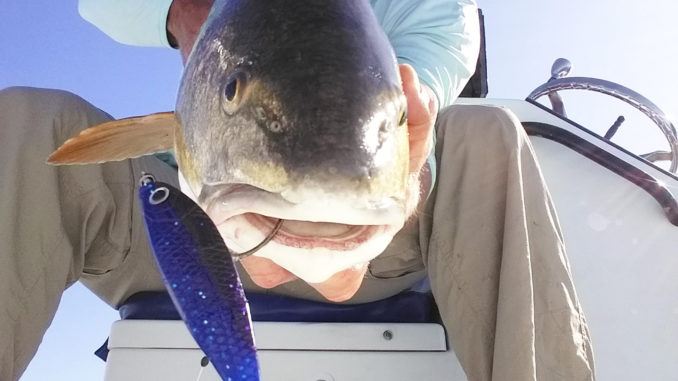
Redfish make a big move this month along the southeastern North Carolina coast
Rennie Clark Jr., a guide and redfish tournament fisherman, calls this month “Red October” along the North Carolina coast north and east of Cape Fear River.
“Red-drum fishing is usually the best this month,” said Clark, 42, of Carolina Beach-based Tournament Trail Charters. “But it depends on when the mullet run starts and stops.”
Although Native Americans call October the “Month of the Hunting Moon,” it applies to fish as well. Reds and other species usually begin to move south at the first hint of cooler weather, normally during mid-fall.
“Actually, the mullet run started early because of all the rain in August,” said Clark (910-465-8943), who chases redfish from Bogue Inlet to mouth of the Cape Fear River. “A couple weeks after the rain, nothing was inside.
“But when we have a few nights in a row when the (air) temperature drops into the 50s, it cools down the water to the 70s, and the mullet runs start.”
From jumpers to finger sizes, mullet and shrimp flow out inlets from inside waters and scurry south along the surf zone. Red drum, from “rats” to bulls, follow.
After the first mullet blow — a storm or hard wind from the northeast, Clark targets choke points that include inlets where baitfish and shrimp migrate toward the Atlantic.
“Red drum, flounder, spotted seatrout and sharks wait for baits at inlets and in the ‘suds’,” he said.
Clark prefers artificial lures when he’s fishing with experienced anglers. For novice clients, Clark favors live baits and popping-cork rigs.
“Sight-fishing for reds is best when the water cools down and clears up,” he said. “I’ve seen schools of 1,000 fish on calm days. When the sun gets up, you can see ’em just under the surface.”
A north wind is favorable at most venues south of Cape Lookout because it creates small waves and makes sight-fishing easier. However, Clark and his tournament partners have won their last two IFA tournaments on oyster shells in bays behind barrier islands.
“Some resident fish will stay in skinny water (behind barrier islands) in October, but most of them are on the move,” he said. “Anywhere there’s a good drop-off near the end of an oyster point is a good place to catch redfish on a falling tide.”
When the water’s clear enough for sight-fishing, Clark often casts a 3- to 3½-inch green/blue stripes Category 5 Manic Minnow or a Suicide Croaker threaded onto a weedless 1/8- to 1/16-ounce Eye Strike jighead.
“I like a lot of natural colors for clear water: clear brown, green or blue,” Clark said. “I want my lures to look natural if I throw ’em at a school of reds, especially if they’re after baitfish on the surface. But a biologist told me tests showed redfish and trout prefer blue in lures.”
Clark uses heavier, ¼-ounce, jigheads if there’s strong current or wind.
“If I want to skip a light lure, I’ll sometimes crimp a 1/8-ounce split-shot (up the line),” said Clark, who uses two basic set-ups for redfish, including a medium-light, 7-foot St. Croix Triumph rod mated to a 2500 or 3000 Series Shimano or Stradic spinning reel and a medium-action rod for popping-cork or bottom rigs.
“If I soak live baits, I’ll use ½-ounce jigheads,” he said. “But if I’m fishing for bull reds, I like a medium-action rod with heavier line and throw a Rapala Skitter Walk 11 or a big MirrOlure.”
Clark’s light-rod reel backing includes 15-pound Tuf-Line braid, but he spools 20- or 30-pound test braid onto reels mated to medium-action rods. He ties 18 inches of 20- or 30-pound Sufix Invisi-Line fluorocarbon leaders to his braid.
“There are dozens of choke points and inlets up and down the coast that have baitfish going into the ocean and down the beaches in October when the water temperature gets right — with reds right on their tails,” Clark said. “Seeing 1,000 redfish in a school is something you don’t forget.”




Be the first to comment